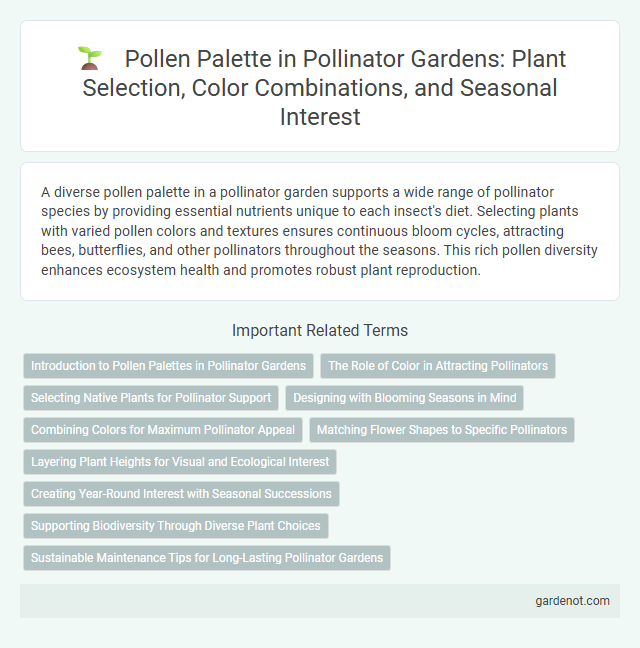A diverse pollen palette in a pollinator garden supports a wide range of pollinator species by providing essential nutrients unique to each insect's diet. Selecting plants with varied pollen colors and textures ensures continuous bloom cycles, attracting bees, butterflies, and other pollinators throughout the seasons. This rich pollen diversity enhances ecosystem health and promotes robust plant reproduction.
Introduction to Pollen Palettes in Pollinator Gardens
Pollen palettes in pollinator gardens consist of diverse flowering plants selected to provide a continuous and abundant source of pollen throughout the growing season. These palettes support a variety of pollinators, including bees, butterflies, and other beneficial insects, by offering nutrient-rich pollen essential for their development and reproduction. Strategically curated pollen palettes enhance garden biodiversity and promote healthy pollinator populations, contributing to ecosystem stability and improved crop pollination.
The Role of Color in Attracting Pollinators
The pollen palette plays a crucial role in attracting pollinators by offering vibrant colors that signal nectar availability. Different pollinators, such as bees and butterflies, are drawn to specific hues like ultraviolet patterns and bright yellows or purples. This diverse color spectrum enhances pollination efficiency by guiding insects directly to pollen-rich flowers.
Selecting Native Plants for Pollinator Support
Selecting native plants for pollinator gardens enhances local biodiversity by providing essential pollen and nectar resources tailored to native pollinators' needs. Native species like coneflowers, milkweed, and goldenrod create a diverse pollen palette that supports bees, butterflies, and other pollinators throughout their active seasons. Incorporating a variety of native plants ensures extended bloom periods, promoting consistent food availability and healthier pollinator populations.
Designing with Blooming Seasons in Mind
Selecting a pollen palette that aligns with blooming seasons ensures a continuous food source for pollinators throughout the year. Incorporate early spring bulbs, summer perennials, and late fall wildflowers to maintain a vibrant and diverse habitat. Seasonal planning supports pollinator health by providing varied pollen and nectar supplies across different months.
Combining Colors for Maximum Pollinator Appeal
A well-designed pollen palette combining vibrant hues like yellow, purple, and blue attracts a diverse range of pollinators, including bees, butterflies, and hummingbirds. Strategic color combinations enhance floral visibility, increasing pollinator visitation rates and promoting effective pollination. Integrating complementary and contrasting bloom colors throughout the growing season sustains continuous interest and supports ecosystem health.
Matching Flower Shapes to Specific Pollinators
Selecting flowers with shapes that correspond to the feeding structures of specific pollinators enhances pollen transfer efficiency in a pollinator garden. Tubular flowers cater to hummingbirds' long beaks, while flat, open blossoms attract butterflies and bees by providing easy landing pads. Matching floral morphology with pollinator traits promotes biodiversity and supports ecosystem pollination networks.
Layering Plant Heights for Visual and Ecological Interest
Layering plant heights in a pollinator garden creates diverse habitats, attracting various pollinators such as bees, butterflies, and hummingbirds by providing accessible pollen sources at multiple levels. Taller plants like coneflowers and sunflowers offer vertical structure and shelter, while mid-height asters and phlox fill the middle layer, and low-growing groundcovers such as creeping thyme ensure continuous nectar availability near the soil. This stratification enhances both visual appeal and ecological function by promoting biodiversity and sustained pollinator activity throughout the growing season.
Creating Year-Round Interest with Seasonal Successions
A diverse pollen palette ensures continuous nectar and pollen availability, supporting pollinators throughout the year. Incorporating seasonal successions of flowering plants like crocuses in early spring, coneflowers in summer, and asters in fall maintains habitat sustainability and boosts biodiversity. This strategic planting enhances ecosystem stability and promotes pollinator health by providing consistent food sources.
Supporting Biodiversity Through Diverse Plant Choices
A vibrant pollen palette supports biodiversity by attracting a wide range of pollinators, including bees, butterflies, and hummingbirds. Incorporating diverse native plants with varying bloom times ensures continuous pollen availability throughout the growing season, promoting ecosystem health. This strategic plant selection enriches habitats, sustains pollinator populations, and enhances overall garden resilience.
Sustainable Maintenance Tips for Long-Lasting Pollinator Gardens
Pollen palette diversity enhances pollinator attraction and supports ecosystem balance in sustainable gardens. Incorporate native flowering plants with staggered bloom times to provide continuous pollen sources throughout the seasons. Employ organic mulching, water conservation techniques, and minimal pesticide use to maintain soil health and promote pollinator-friendly habitats for long-lasting garden vitality.
Pollen palette Infographic

 gardenot.com
gardenot.com